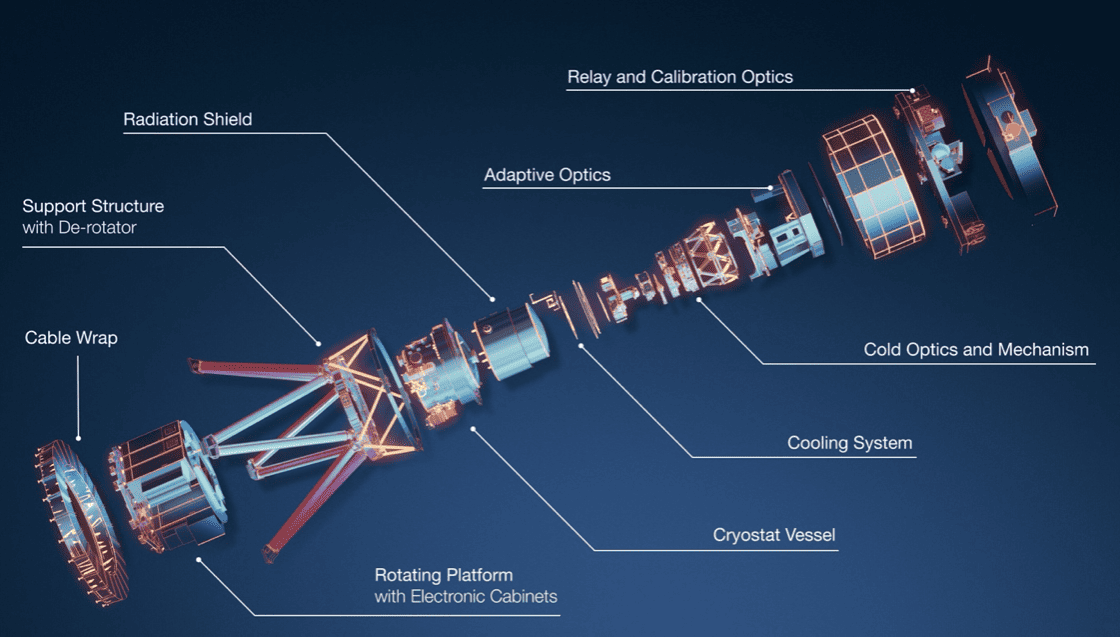
The FDR (final design review) process, which has lasted several years, has just been completed.
While the manufacture of an instrument generally begins only after the FDR has been adopted, the go-ahead for the procurement of many components and subsystems has already been given, to enable the MICADO project to progress towards the first light of the ELT, scheduled for the end of 2028.
To complete this review, the consortium members have been working with ESO staff to clarify the questions still open concerning the instrument’s design.
Optimized instrument design
MICADO has been designed to achieve very high precision and stability in order to achieve the sensitivity, angular resolution, astrometric accuracy and broad spectral coverage required by the instrument’s ambitious scientific objectives.
To achieve this in the ELT environment, MICADO will intercept telescope light with an optical relay, so that telescope light can be relayed both :
- into the instrument’s cryostat ;
- and to the adaptive optics system, which corrects for the deleterious effects of atmospheric turbulence.

It is in this cryostat that the optics and detectors are kept cold so that they can operate efficiently at near-infrared wavelengths, without interference from other heat sources. Much of the instrument’s operating electronics are mounted just below the cryostat. And instrument control software will enable users to carry out their observations remotely.
Ambitious scientific objectives
This particularly sophisticated design will enable MICADO to obtain high spatial resolution images of the Universe, revealing the detailed structures and formation mechanisms of distant galaxies.
It will also enable astronomers to study individual stars and stellar systems in nearby galaxies, as well as planets and their formation outside our own solar system.
In addition, MICADO will be a particularly powerful tool for exploring environments where gravitational forces are extremely strong, such as near the supermassive black hole at the center of our Milky Way galaxy.
Après les premières années d’exploitation scientifique avec le mode d’optique adaptative de première lumière, les capacités de MICADO seront renforcées grâce à un couplage avec l’instrument MORFEO (Multiconjugate adaptive Optics Relay For ELT Observations). Avec ce dernier, MICADO bénéficiera de deux modes d’optique adaptative et obtiendra des images nettes sur une plus grande région du ciel.
The MICADO consortium
With 150 members in six countries, the MICADO consortium brings together the following institutions :
- MPE (Max-Planck-Institut für Extraterrestrische Physik, Germany),
- MPIA (Max-Planck-Institut für Astronomie, Germany),
- USM (Universitäts-Sternwarte München, Germany),
- IAG (Institute for Astrophysics of the Georg-August-Universität Göttingen, Germany),
- NOVA (Netherlands Research School for Astronomy represented by the University of Groningen,
- Leiden University, and NOVA’s optical/infrared instrumentation group based at ASTRON in Dwingeloo, the Netherlands),
- INAF Istituto Nazionale di Astrofisica,
- CNRS/INSU (Centre National de la Recherche Scientifique/Institut National des Sciences de l’Univers represented by LESIA de l’Observatoire de Paris - PSL, GEPI de l’Observatoire de Paris - PSL, as well as INSU Technical Division, UTINAM/OSU THETA, LCF and IP2I/LMA, in France.
| French contributions The know-how of French laboratories, internationally recognized for their expertise in high angular resolution techniques, is being used to develop some of the instrument’s most critical subsystems. These include the laboratories of Observatoire de Paris - PSL, LESIA and GEPI, as well as the joint research units UTINAM, LCF, IP2I, Observatoire des Sciences de l’Univers Theta and INSU’s Technical Division. Within the MICADO consortium, CNRS is responsible for the development of two critical subsystems of the instrument :
|
- A* (an Austrian partnership represented by the University of Vienna,
- University of Innsbruck,
- the University of Linz and RICAM Linz, (Austrian Academy of Sciences, Austria),
- and the Finnish Center for Astronomy with ESO (FINCA), University of Turku, Finland.
The main role of each consortium partner in the project is described here.
For more information
For a full summary of the MICADO project, how it works and how it will reveal the Universe like never before, watch the video (Length : 9 min.) entitled : "Meet MICADO, a super-camera for the ELT".
A description of MICADO is also available on the LESIA website of Paris Observatory - PSL.
